Specifications:
Displacement 512 t.
Length 175'
Beam 51' 2"
Draft 6'
Speed 9 mph
Complement 251
| Click On Image For Full Size Image |
Size | Image Description | Contributed By |
|
|---|---|---|---|---|
| USS St. Louis |
||||
 |
104k | "United States Mississippi Gun-boats being built at Carondelet, near St. Louis, Missouri". Line engraving published in "Harper's Weekly", 5 October 1861. It depicts, rather inaccurately, the construction of four of the "City" class ironclads by James Eads, including Carondelet, Louisville, Pittsburgh and Saint Louis. US Naval History and Heritage Command photo # NH 59001 |
Robert Hurst | |
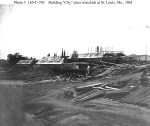 |
89k | "City" Class armored gunboats under construction by James Eads, at St. Louis, Missouri, prior to October 1861. This view shows four ships
being built in pairs, at two levels on the shore, with casemate side timbers largely installed. Vertical timbers extending above the slanting casemate sides are framing
for the ships' paddle-wheel boxes. The four ships of this class built at St. Louis were
Carondelet,
Louisville,
Pittsburgh and
Saint Louis. Note building and flagpole in the right background, timber
stockpile in the foreground, and twin rudder posts at the ships' sterns with the paddle raceway between them.
U.S. National Archives. Photo #: 165-C-703 |
Robert Hurst | |
 |
80k | "Commodore Foote's Gun-boat Flotilla on the Mississippi". Line engraving after a sketch by Alexander Simplot, published in Harper's Weekly,
1862. Ships are identified below the image as (from left to right): USS Mound City, USS Essex, USS Cairo, USS Saint Louis, USS Louisville, USS Benton, USS Pittsburgh and USS Lexington. US Naval History and Heritage Command. Photo #: NH 59002 | Robert Hurst | |
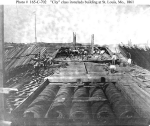 |
111k | "City" Class armored gunboats under construction by James Eads, at St. Louis, Missouri, prior to October 1861. This view looks along the
main deck on one gunboat, with its boilers in the foreground and casemate timbers at the sides. Another vessel is beyond, with some spar deck beams atop the casemate
side timbers and upright framing in place for her wheel box. The four ships of this class built at St. Louis were
Carondelet,
Louisville,
Pittsburgh and
Saint Louis. Note flagpole in the left background.
U.S. National Archives. Photo #: 165-C-702 |
Robert Hurst | |
 |
166k | Wood-cut engraving "WAR IN THE WEST--THE NEW GUNBOAT FLOTILLA, COMMODORE FOOTE BUILT AT CARONDELET MISSOURI, FOR THE DESCENT OF THE MISSISSIPPI", published in "Frank Leslie's Illustrated" December 1861,
Left to Right;
USS Louisville USS Carondelet Transport, name unknown USS Pittsburgh Transport, name unknown USS St. Louis |
Tommy Trampp | |
 |
179k | "Battle of Fort Henry, 6 February 1862." Line engraving after a drawing by Rear Admiral Henry Walke, published in the "History of the Great Rebellion", by Harper. The print depicts the Federal gunboats USS Saint Louis, USS Carondelet, USS Essex and USS Cincinnati bombarding Fort Henry. U.S. Naval Historical Center Photograph. Photo #: NH 42336. Courtesy of Paul H. Silverstone, 1981. |
Robert Hurst | |
 |
77k | "The Gun-boat Attack on the Water Batteries at Fort Donelson". Line engraving, based on a sketch by Alexander Simplot, published in
"Harper's Weekly", 1862, depicting the bombardment of Fort Donelson, Tennessee, by Federal warships, 14 February 1862. Many of the ships were damaged in this action. As
identified on the engraving, they are (from left to right):
"Timberclads" USS Tyler and USS Conestoga; "Ironclads" USS Carondelet, USS Pittsburgh, USS Louisville and USS Saint Louis. US Navy History and Heritage Command photo # NH 58898. |
Robert Hurst | |
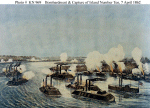 |
114k | "Bombardment and Capture of Island Number Ten on the Mississippi River, April 7, 1862." Colored lithograph published by Currier & Ives, New York, circa 1862. It depicts the bombardment of the Confederate fortifications on Island Number Ten by Federal gunboats and mortar boats. Ships seen include (from left to right): USS Mound City; USS Louisville; USS Pittsburgh; USS Carondelet; USS Benton; USS Cincinnati; USS Saint Louis; USS Conestoga. US Naval History and Heritage Command photo # KN 9691 |
Robert Hurst | |
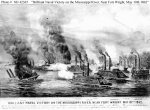 |
126k | "Brilliant Naval Victory on the Mississippi River, Near Fort Wright, May 10th 1862." Brilliant Naval Victory on the Mississippi River, Near Fort Wright, May 10th 1862 by the Union Flotilla of 6 Gunboats, commanded by Com. C.H. Davis, and the Rebel fleet of 8 Iron-clads, under Hollins. The action lasted one hour. Two of the Rebel gunboats were blown up and one sunk, when the remainder retired precipitately under the guns of the fort. Lithograph by Currier & Ives, New York, providing a curious (and quite inaccurate) view of the action off Fort Pillow in which the Confederate River Defense Fleet, under Captain James E. Montgomery, attacked Federal gunboats. The print identifies the following ships (from left to right): CSS Mallory (non-existent vessel), shown sinking); CSS Louisiana (an ironclad that had already been destroyed by this time); USS Cincinnati; USS Benton; USS Cairo; USS Carondelet; USS Saint Louis; and USS Conestoga. US Naval History and Heritage Command photo # NH 42365. Collection of President Franklin D. Roosevelt, April 1936 |
Robert Hurst | |
 |
177k | "The Great Naval Battle before Memphis, June 6, 1862". Engraving after a sketch by Alexander Simplot, published in "Harper's Weekly",
depicting the action between the Confederate River Defense Fleet and Federal warships off Memphis, Tennessee. In the foreground, the print depicts the Confederate ships
(from left to right):
CSS General M. Jeff Thompson (shown sinking); CSS Little Rebel (shown burning); CSS General Sterling Price; CSS General Beauregard (shown being jammed by the Ellet Ram USS Monarch; CSS General Bragg (shown aground) and CSS Colonel Lovell (shown sinking). In the background are the Federal warships (from left to right): USS Queen of the West; USS Cairo; USS Carondelet; USS Louisville; USS Saint Louis; a tug; and USS Benton. The city of Memphis is in the right distance, with a wharf boat by the shore. Harpers Weekly, 28 June 1862. Sons of the South - Memphis Naval Battle US Naval History and Heritage Command photo # NH 58891 |
Robert Hurst | |
 |
122k | "Battle at St. Charles, White River, Arkansas--Explosion of the USS Mound City". Line engraving after a sketch by Alexander Simplot, published in Harper's Weekly, 1862. This action between Federal gunboats and Confederate shore batteries took place on 17 June 1862. USS Mound City was disabled by a shot that penetrated her steam drum, causing heavy casualties among her crew. Other U.S. ships present were the ironclad USS Saint Louis (seen in the right foreground) and "timberclads" USS Lexington and USS Conestoga. The gunboat in left center is a "timberclads". U.S. Naval History and Heritage Command Photo #NH 59057. |
Robert Hurst | |
| USS Baron De Kalb |
||||
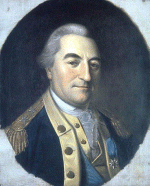 |
36k | KALB, Johann, called Baron de Kalb (1721-80), German-born soldier, who fought in the American Revolution. Born in Hüttendorf, near Bayreuth, in Bavaria, he became a lieutenant in a German regiment of the French army at the age of 22; he fought with distinction in the War of the Austrian Succession and the Seven Years' War, rising to the rank of brigadier general by 1761. In 1768 Kalb was sent to America as an agent of the French government to determine the attitude of the colonies toward Great Britain. He returned to America in 1777 and joined the revolutionary army with the rank of major general. He served briefly under Gen. George Washington before the winter encampment at Valley Forge and later was sent south to help Gen. Horatio Gates. He was second in command to Gates at the disastrous Battle of Camden, S.C., in August 1780. Kalb's troops were finally forced to retreat before the army of Lord Charles Cornwallis, but Kalb himself was wounded and captured by the British. He died of wounds three days after his capture. |
Tommy Trampp | |
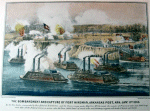 |
152k | Currier & Ives Lithographed and hand colored Civil War Battle Scene print from 1960. "THE BOMBARDMENT AND CAPTURE OF FORT HINDMAN, ARKANSAS
POST, ARK., JAN.11, 1863". Hand colored though silk-screen stencils this Civil War print came from a limited edition in 1960. Ships participating in the bombardment include: USS Baron De Kalb USS Cincinnati USS Louisville USS Black Hawk and USS Rattler |
Tommy Trampp | |
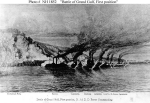 |
155k | "Battle of Grand Gulf, First position, R. Ad. D.D. Porter Commanding". Engraving published in Rear Admiral Henry Walke's Naval Scenes
and Reminiscences of the Civil War in the United States ... (1877), depicting U.S. Navy ironclads engaging Confederate batteries at Grand Gulf, Mississippi, 29 April 1863.
US ships present, as identified on the print, are (from left-center to right): USS Benton, USS Tuscumbia, USS Pittsburgh, USS Lafayette, USS Louisville, USS Baron De Kalb, (Identified as St. Louis in the engraving) and USS Carondelet,. US Naval History and Heritage Command Photo # NH 1852 |
Robert Hurst | |
 |
101k | "City" Class ironclad gunboats off Cairo, Illinois, in 1863, with barges moored in the foreground. These ships are (from left to right); USS Baron de Kalb, USS Cincinnati and USS Mound City. Boats are tied astern of Baron de Kalb and Cincinnati. U.S. Naval Historical Center Photograph. Photo # NH 56663-A. Courtesy of Paul H. Silverstone, 1981. | Robert Hurst | |
 |
242k | USS Baron DeKalb, circa 1862, location unknown. Photographer unknown. U.S. National Archives and Records Administration, cataloged under the ARC Identifier (National Archives Identifier) 533123. |
Robert Hurst | |
 |
168k | Line engraving by George Perine & Co., New York, circa 1865 of USS Baron De Kalb
US Naval History and Heritage Command photo # NH 78178. |
Aryeh Wetherhorn | |
 |
55k | Watercolor by Oscar Parkes of USS Baron De Kalb. Courtesy of Dr. Oscar Parkes, London, England, 1936.
US Naval History and Heritage Command photo # NH 59547. |
Aryeh Wetherhorn | |
USS St. Louis / USS Baron De Kalb
Dictionary of American Naval Fighting Ships (DANFS)
Additional Resources and Web Sites of Interest
Pook's Turtles by Aryeh Wetherhorn
| Back To The Navsource Photo Archives Main Page | Back To The Old Navy" Steam and Sail Index |
| Comments, Suggestions, E-mail Webmaster. |
|
This page is created and maintained by Gary P. Priolo |